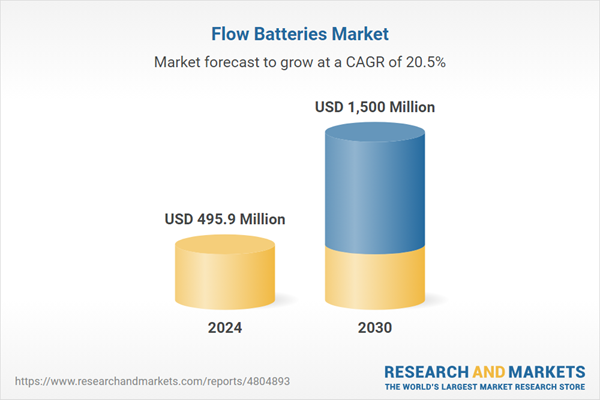The global market for Flow Batteries was valued at US$495.9 Million in 2024 and is projected to reach US$1.5 Billion by 2030, growing at a CAGR of 20.5% from 2024 to 2030. This comprehensive report provides an in-depth analysis of market trends, drivers, and forecasts, helping you make informed business decisions.
Flow batteries possess distinct advantages over traditional batteries, such as lead-acid or lithium-ion, particularly in terms of longevity, safety, and operational flexibility. They are capable of withstanding thousands of charge-discharge cycles with minimal degradation, which can translate to operational spans of over 20 years. This makes them an attractive option for applications that require frequent and deep cycling like renewable energy integration, where they can store excess solar or wind energy during peak production times and release it during demand spikes. Additionally, flow batteries are non-flammable and exhibit low environmental impact, which addresses safety and ecological concerns associated with other battery chemistries. Furthermore, their ability to independently scale energy and power allows for customized installations tailored to specific needs, from small-scale commercial operations to large utility-based installations.
The growth in the flow battery market is driven by several factors, primarily the global shift towards renewable energy sources and the need for more efficient, large-scale energy storage solutions. The increasing penetration of intermittent renewable energy sources like solar and wind into the energy mix demands advanced storage solutions that can mitigate issues related to energy variability and ensure a stable energy supply. Governments and regulatory bodies worldwide are also promoting the adoption of green energy technologies through incentives and mandates, which directly supports the deployment of technologies like flow batteries. Technological advances that reduce costs and improve the efficiency and lifespan of flow batteries further stimulate market growth. Consumer and investor awareness regarding the benefits of sustainable and reliable energy storage solutions continues to rise, fostering a favorable market environment. As a result, the demand for flow batteries is anticipated to grow significantly as part of the broader trend towards sustainability and energy independence in global energy markets.
Global Flow Batteries Market - Key Drivers and Trends Summarized
Flow batteries are a type of rechargeable battery where energy is generated by two chemical components dissolved in liquids contained within the system and separated by a membrane. The key characteristic that distinguishes flow batteries from conventional types is that the energy storage capacity is determined by the size of the liquid storage tanks, while the power output is determined by the size of the cell stack. This unique design enables flow batteries to be scaled more easily than solid-state batteries, making them especially suitable for large-scale energy storage applications, such as stabilizing renewable energy output and enhancing grid stability.Flow batteries possess distinct advantages over traditional batteries, such as lead-acid or lithium-ion, particularly in terms of longevity, safety, and operational flexibility. They are capable of withstanding thousands of charge-discharge cycles with minimal degradation, which can translate to operational spans of over 20 years. This makes them an attractive option for applications that require frequent and deep cycling like renewable energy integration, where they can store excess solar or wind energy during peak production times and release it during demand spikes. Additionally, flow batteries are non-flammable and exhibit low environmental impact, which addresses safety and ecological concerns associated with other battery chemistries. Furthermore, their ability to independently scale energy and power allows for customized installations tailored to specific needs, from small-scale commercial operations to large utility-based installations.
The growth in the flow battery market is driven by several factors, primarily the global shift towards renewable energy sources and the need for more efficient, large-scale energy storage solutions. The increasing penetration of intermittent renewable energy sources like solar and wind into the energy mix demands advanced storage solutions that can mitigate issues related to energy variability and ensure a stable energy supply. Governments and regulatory bodies worldwide are also promoting the adoption of green energy technologies through incentives and mandates, which directly supports the deployment of technologies like flow batteries. Technological advances that reduce costs and improve the efficiency and lifespan of flow batteries further stimulate market growth. Consumer and investor awareness regarding the benefits of sustainable and reliable energy storage solutions continues to rise, fostering a favorable market environment. As a result, the demand for flow batteries is anticipated to grow significantly as part of the broader trend towards sustainability and energy independence in global energy markets.
Scope of the Study
The report analyzes the Flow Batteries market, presented in terms of market value (US$ Thousand). The analysis covers the key segments and geographic regions outlined below.Segments:
Material (Vanadium, Zinc-Bromine, Other Materials); Application (Utilities, Commercial & Industrial, Residential, Other Applications).Geographic Regions/Countries:
World; United States; Canada; Japan; China; Europe (France; Germany; Italy; United Kingdom; and Rest of Europe); Asia-Pacific; Rest of World.Key Insights:
- Market Growth: Understand the significant growth trajectory of the Zinc-Bromine Flow Batteries segment, which is expected to reach US$361.3 Million by 2030 with a CAGR of a 22.4%. The Vanadium Flow Batteries segment is also set to grow at 20.1% CAGR over the analysis period.
- Regional Analysis: Gain insights into the U.S. market, valued at $109.3 Million in 2024, and China, forecasted to grow at an impressive 24.5% CAGR to reach $234.8 Million by 2030. Discover growth trends in other key regions, including Japan, Canada, Germany, and the Asia-Pacific.
Report Features:
- Comprehensive Market Data: Independent analysis of annual sales and market forecasts in US$ Million from 2024 to 2030.
- In-Depth Regional Analysis: Detailed insights into key markets, including the U.S., China, Japan, Canada, Europe, Asia-Pacific, Latin America, Middle East, and Africa.
- Company Profiles: Coverage of major players such as CERQ/JenaBatteries GmbH, Elestor BV, ESS, Inc., Invinity Energy Systems Plc, Kemwatt SAS and more.
- Complimentary Updates: Receive free report updates for one year to keep you informed of the latest market developments.
Why You Should Buy This Report:
- Detailed Market Analysis: Access a thorough analysis of the Global Flow Batteries Market, covering all major geographic regions and market segments.
- Competitive Insights: Get an overview of the competitive landscape, including the market presence of major players across different geographies.
- Future Trends and Drivers: Understand the key trends and drivers shaping the future of the Global Flow Batteries Market.
- Actionable Insights: Benefit from actionable insights that can help you identify new revenue opportunities and make strategic business decisions.
Key Questions Answered:
- How is the Global Flow Batteries Market expected to evolve by 2030?
- What are the main drivers and restraints affecting the market?
- Which market segments will grow the most over the forecast period?
- How will market shares for different regions and segments change by 2030?
- Who are the leading players in the market, and what are their prospects?
Some of the 77 major companies featured in this Flow Batteries market report include:
- CERQ/JenaBatteries GmbH
- Elestor BV
- ESS, Inc.
- Invinity Energy Systems Plc
- Kemwatt SAS
- Largo Inc.
- LE SYSTEM Co., Ltd.
- Lockheed Martin Corporation
- nanoFlowcell Management AG
- Primus Power Corp.
- Redflow Ltd.
- Sumitomo Electric Industries, Ltd.
- ViZn Energy Systems, Inc.
- Volterion GmbH & Co. KG
- VoltStorage GmbH
- VRB® Energy
Table of Contents
I. METHODOLOGYMII. EXECUTIVE SUMMARY2. FOCUS ON SELECT PLAYERSIII. MARKET ANALYSISIV. COMPETITION
1. MARKET OVERVIEW
3. MARKET TRENDS & DRIVERS
4. GLOBAL MARKET PERSPECTIVE
UNITED STATES
CANADA
JAPAN
CHINA
EUROPE
FRANCE
GERMANY
ITALY
UNITED KINGDOM
REST OF EUROPE
ASIA-PACIFIC
REST OF WORLD
Table Information
| Report Attribute | Details |
|---|---|
| No. of Pages | 350 |
| Published | February 2025 |
| Forecast Period | 2024 - 2030 |
| Estimated Market Value ( USD | $ 495.9 Million |
| Forecasted Market Value ( USD | $ 1500 Million |
| Compound Annual Growth Rate | 20.5% |
| Regions Covered | Global |









